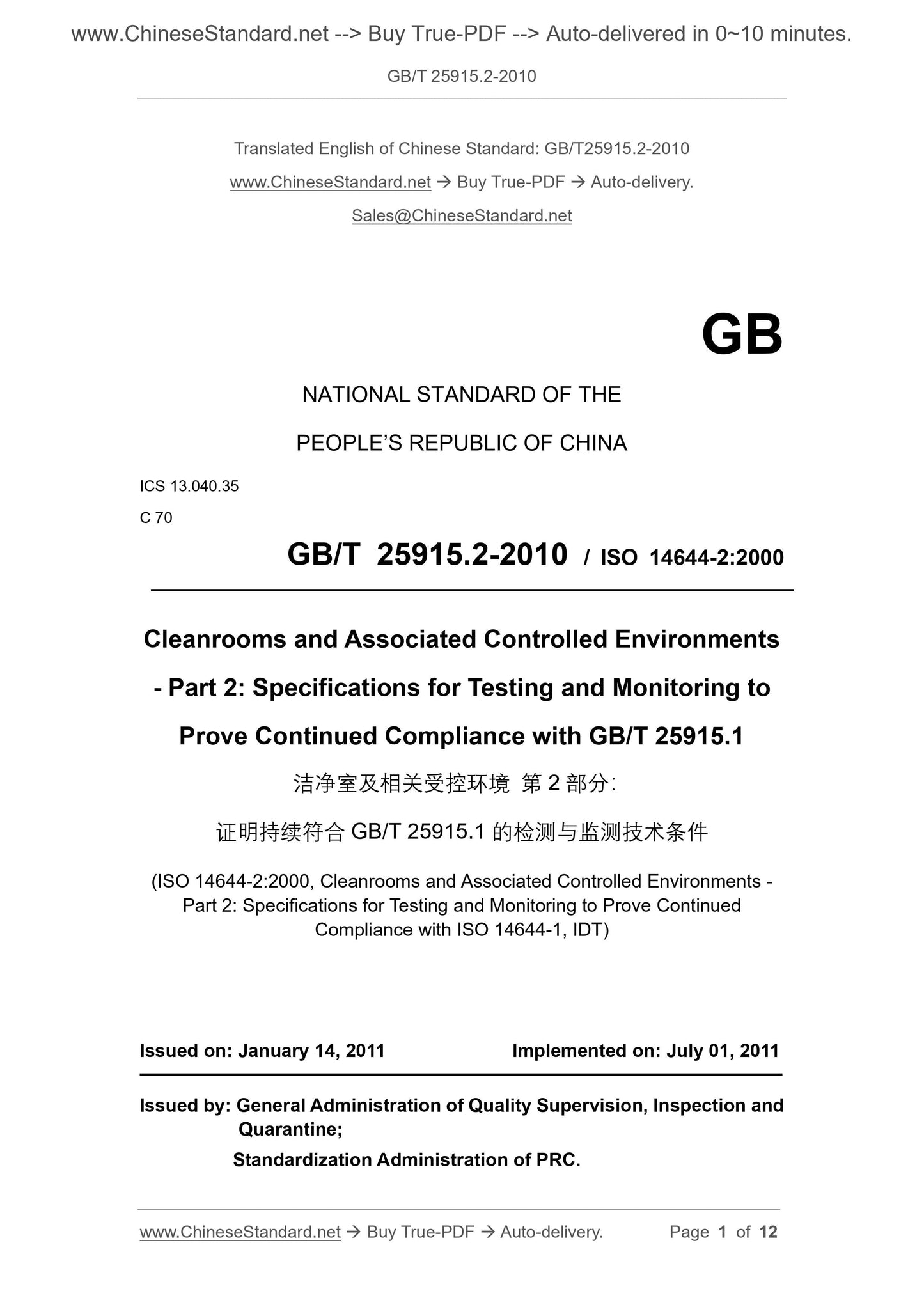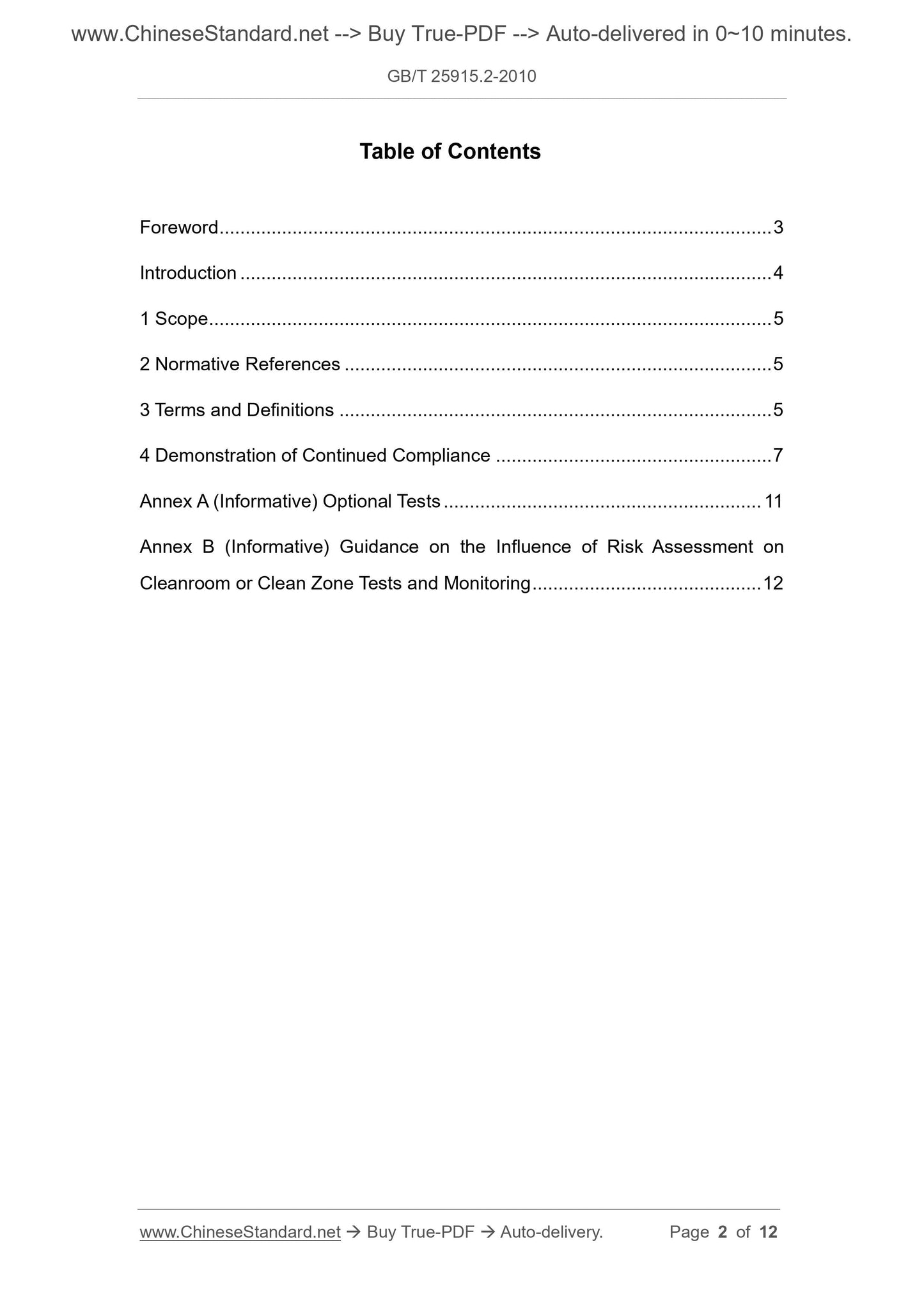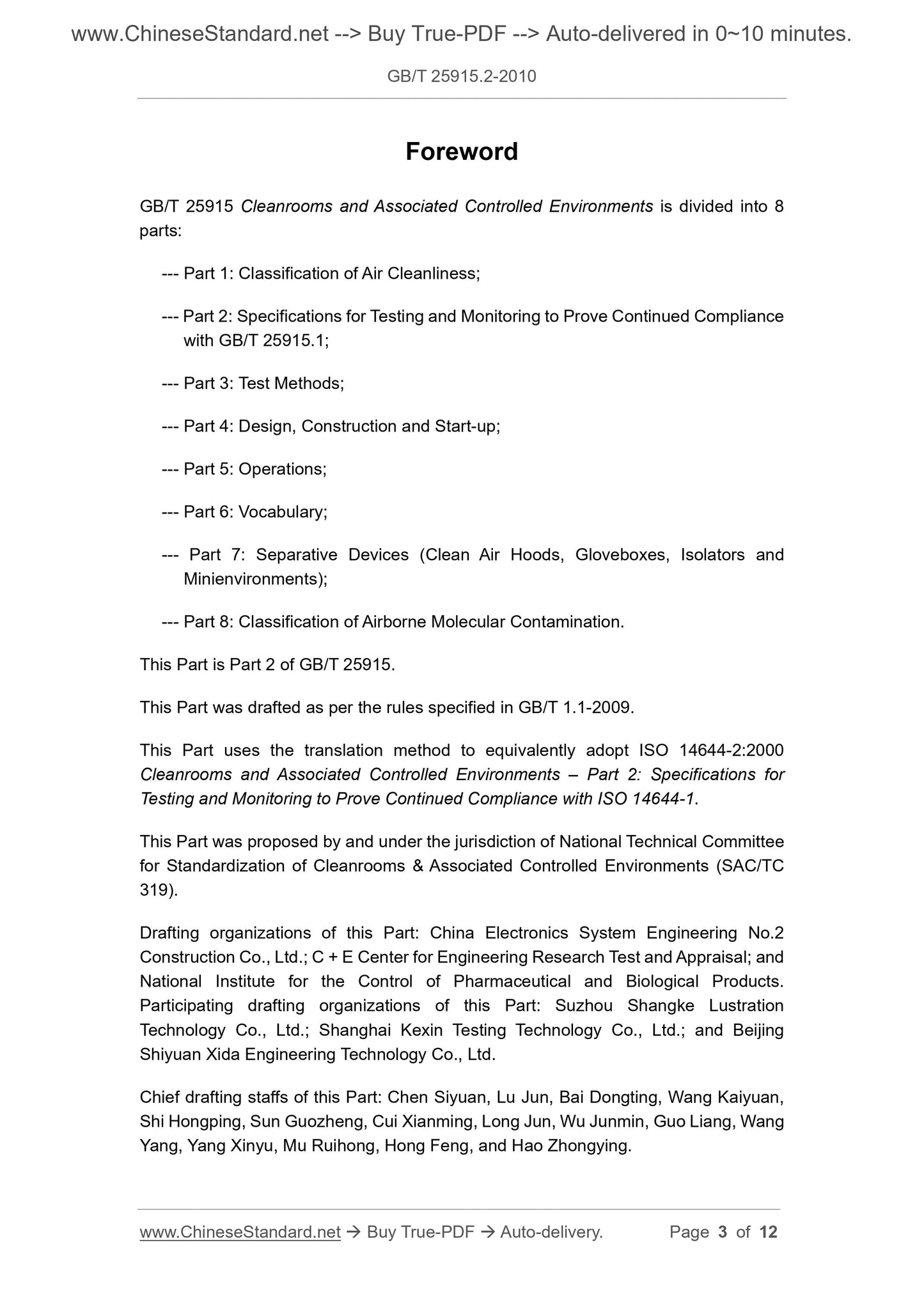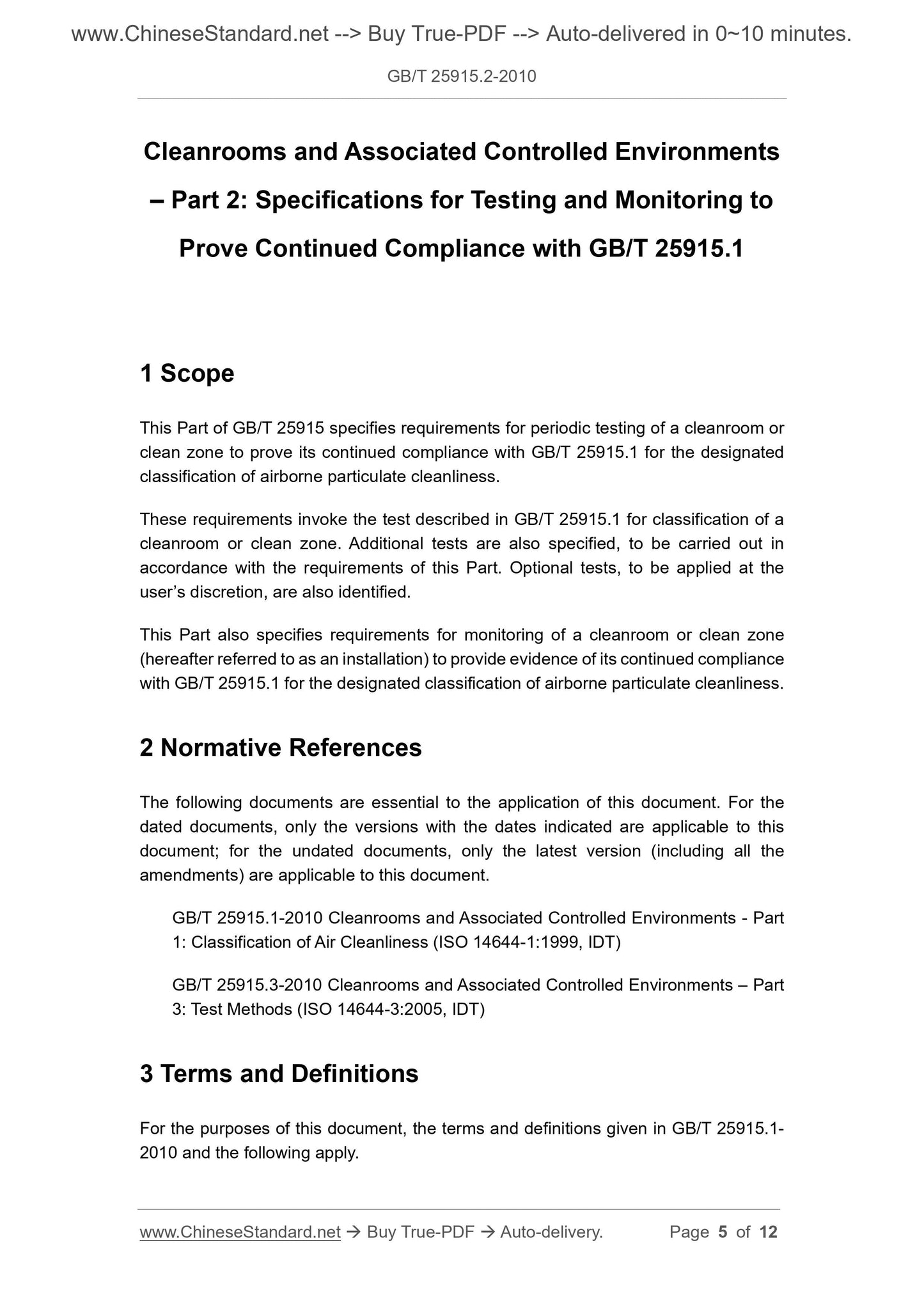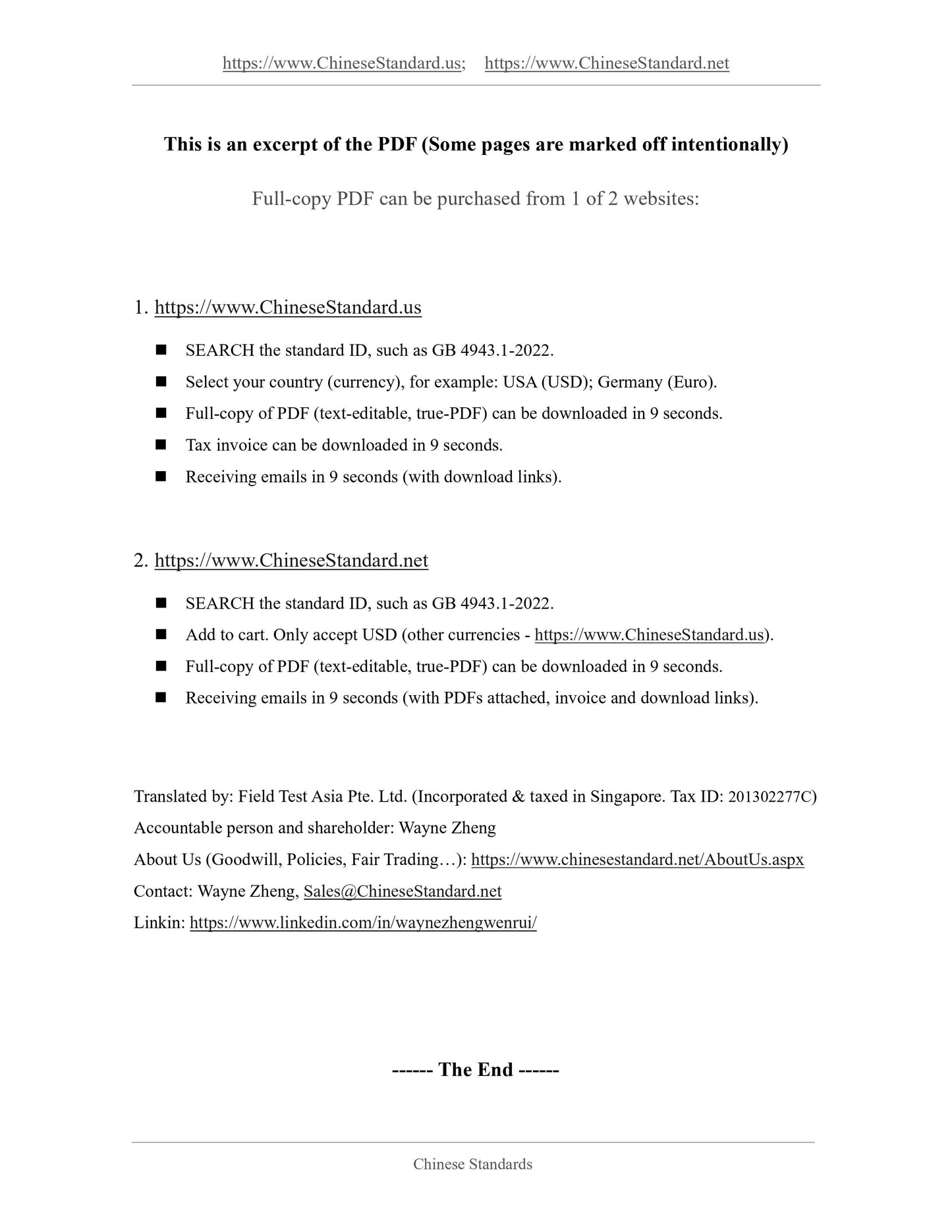1
/
von
5
PayPal, credit cards. Download editable-PDF and invoice in 1 second!
GB/T 25915.2-2010 English PDF (GBT25915.2-2010)
GB/T 25915.2-2010 English PDF (GBT25915.2-2010)
Normaler Preis
$170.00 USD
Normaler Preis
Verkaufspreis
$170.00 USD
Grundpreis
/
pro
Versand wird beim Checkout berechnet
Verfügbarkeit für Abholungen konnte nicht geladen werden
Delivery: 3 seconds. Download true-PDF + Invoice.
Get QUOTATION in 1-minute: Click GB/T 25915.2-2010
Historical versions: GB/T 25915.2-2010
Preview True-PDF (Reload/Scroll if blank)
GB/T 25915.2-2010: Cleanrooms and associated controlled environments -- Part 2: Specifications for testing and monitoring to prove continued compliance with GB/T 25915.1
GB/T 25915.2-2010
Cleanrooms and associated controlled environments - Part 2.Specifications for testing and monitoring to prove continued compliance with GB/T 25915.1
ICS 13.040.35
C70
National Standards of People's Republic of China
Clean room and related controlled environment
Part 2.Demonstrating continued compliance
GB/T 25915.1 technical conditions for testing and monitoring
continuedcompliancewithGB/T 25915.1
(ISO 14644-2..2000, Cleanroomsandassociatedcontroledenvironments-
continuedcompliancewithISO 14644-1, IDT)
Released on.2011-01-14 and implemented on.2011-06-01
General Administration of Quality Supervision, Inspection and Quarantine of the People's Republic of China
Issued by China National Standardization Administration
Preface
GB/T 25915 "Clean Room and Related Controlled Environment" is divided into eight parts.
---Part 1.Air cleanliness grade;
---Part 2.Prove continuous compliance with GB/T 25915.1 testing and monitoring technical conditions;
---Part 3.Detection method;
---Part 4.Design, construction, start-up;
---Part 5.Operation;
---Part 6.Vocabulary;
---Part 7.Isolation device (clean wind hood, glove box, isolator, microenvironment);
---Part 8.Classification of air molecular pollution.
This part is Part 2 of GB/T 25915.
This section was drafted in accordance with the rules given in GB/T 1.1-2009.
The translation method used in this part is equivalent to ISO 14644-2.2000 "Cleanrooms and related controlled environments Part 2.Proof of continuous compliance
Technical conditions for testing and monitoring in compliance with ISO 14644-1.
This part is proposed and managed by the National Standardization Technical Committee for Cleanrooms and Related Controlled Environments (SAC/TC319).
This part is composed of China Electronic System Engineering Second Construction Co., Ltd., China Power Investment Engineering Research and Evaluation Center, China Pharmaceutical Biological Products
The inspection institute is responsible for drafting, Suzhou Shangke Clean Technology Co., Ltd. Shanghai Kexin Testing Technology Co., Ltd., Beijing Shiyuan Xida Engineering Technology Co., Ltd.
Participate in drafting.
The main drafters of this section. Chen Siyuan, Lu Jun, Bai Dongting, Wang Kaiyuan, Shi Hongping, Sun Guozheng, Cui Xianming, Long Jun, Wu Junmin, Guo Liang,
Wang Yang, Yang Xinyu, Mu Ruihong, Hong Feng, Hao Zhongying.
introduction
This part of GB/T 25915 provides a method to prove that the clean room and related controlled environment continue to comply with GB/T 25915.1, and specifies
The minimum requirements for testing and monitoring have been established. In the inspection plan, the specific operational requirements, the risk assessment of the facility and the use of the facility must also be considered.
Clean rooms and related controlled environments control pollutants in the air at an appropriate level to complete pollution-sensitive operations. Products and
The areas where processes benefit from air pollutant control are. aerospace, microelectronics, pharmaceuticals, medical equipment, food, medical and health industries. apart from
In addition to the concentration of airborne particles, there are many other considerations in the design, technical conditions, operation and control of clean rooms and related controlled environments.
factor.
On some occasions, relevant regulatory agencies may stipulate supplementary policies or restrictions. In this case, it may be necessary to
Method to make appropriate adjustments.
Clean room and related controlled environment
Part 2.Demonstrating continued compliance
GB/T 25915.1 technical conditions for testing and monitoring
1 Scope
This part of GB/T 25915 specifies the requirements for regular inspections of clean rooms or clean areas to prove that they continue to meet
The concentration level of airborne particles specified in GB/T 25915.1.
These requirements include the classification test of clean room or clean area described in GB/T 25915.1.In addition, it also stipulates that according to the requirements of this part
Other testing items implemented. The optional testing items that can be implemented according to user requirements are also explained in this section.
This part also specifies the monitoring requirements for clean rooms or clean areas (hereinafter referred to as "facility") to provide continuous compliance
Evidence of the concentration level of airborne particles specified in GB/T 25915.1.
2 Normative references
The following documents are indispensable for the application of this document. For dated reference documents, only the dated version applies to this article
Pieces. For undated references, the latest version (including all amendments) applies to this document.
GB/T 25915.1-2010 Clean room and related controlled environment Part 1.Air cleanliness grade (ISO 14644-1.1999,
IDT)
GB/T 25915.3-2010 Clean room and related controlled environment Part 3.Testing method (ISO 14644-3.2005, IDT)
3 Terms and definitions
The following terms and definitions defined in GB/T 25915.1-2010 apply to this document.
3.1 General terms
3.1.1
Requalification
The facility is tested in accordance with the prescribed test sequence, including verification of the selected pre-test conditions to prove that the facility complies with
The cleanliness grade of GB/T 25915.1.
3.1.2
Test
To determine the performance of a facility or a part of it, a procedure implemented in accordance with a prescribed method.
3.1.3
Monitoring
Testing performed in accordance with prescribed methods and plans to verify the performance of the facility.
Note. This information can be used to find trends under dynamic conditions and provide support for the process.
3.2 Terminology of detection cycle
3.2.1
Continuous monitoring
Uninterrupted monitoring.
3.2.2
Frequent monitoring
The monitoring interval does not exceed 60min during operation.
3.2.3
6 months 6months
During the whole dynamic operation period, the average interval of periodic re-inspection does not exceed 183d, and the longest interval does not exceed a period of 190d.
3.2.4
12months12months
During the whole dynamic operation period, the average interval of periodic re-inspection does not exceed 366d, and the longest interval does not exceed 400d cycles.
3.2.5
24months 24months
During the entire dynamic operation period, the average interval of periodic re-inspection does not exceed 731d, and the longest interval does not exceed a period of 800d.
4 Proof of continuous compliance
4.1 Overview
Carry out required tests and record the test results in the form of documents to verify that the clean room continues to meet the required air cleanliness
(ISO grade) requirements. The monitoring data is used to indicate the condition of the facility and can be used to determine the frequency of detection.
4.2 Testing to prove continuous compliance
4.2.1 Table 1 shows the standard test methods and the longest test period used to prove that the required ISO level is continuously achieved.
Table 1 The detection period to confirm that the particle concentration limit is continuously met
Longest period detection method of grade
≤ISO Level 5 6 months GB/T 25915.1-2010 Appendix B
>ISO Level 5 12 months GB/T 25915.1-2010 Appendix B
Note. Generally, the particle counting detection is carried out in the dynamic state according to the specified ISO grade, but it can also be carried out in the static state.
4.2.2 Where required, the tests listed in Table 2 should be carried out to prove that the requir...
Get QUOTATION in 1-minute: Click GB/T 25915.2-2010
Historical versions: GB/T 25915.2-2010
Preview True-PDF (Reload/Scroll if blank)
GB/T 25915.2-2010: Cleanrooms and associated controlled environments -- Part 2: Specifications for testing and monitoring to prove continued compliance with GB/T 25915.1
GB/T 25915.2-2010
Cleanrooms and associated controlled environments - Part 2.Specifications for testing and monitoring to prove continued compliance with GB/T 25915.1
ICS 13.040.35
C70
National Standards of People's Republic of China
Clean room and related controlled environment
Part 2.Demonstrating continued compliance
GB/T 25915.1 technical conditions for testing and monitoring
continuedcompliancewithGB/T 25915.1
(ISO 14644-2..2000, Cleanroomsandassociatedcontroledenvironments-
continuedcompliancewithISO 14644-1, IDT)
Released on.2011-01-14 and implemented on.2011-06-01
General Administration of Quality Supervision, Inspection and Quarantine of the People's Republic of China
Issued by China National Standardization Administration
Preface
GB/T 25915 "Clean Room and Related Controlled Environment" is divided into eight parts.
---Part 1.Air cleanliness grade;
---Part 2.Prove continuous compliance with GB/T 25915.1 testing and monitoring technical conditions;
---Part 3.Detection method;
---Part 4.Design, construction, start-up;
---Part 5.Operation;
---Part 6.Vocabulary;
---Part 7.Isolation device (clean wind hood, glove box, isolator, microenvironment);
---Part 8.Classification of air molecular pollution.
This part is Part 2 of GB/T 25915.
This section was drafted in accordance with the rules given in GB/T 1.1-2009.
The translation method used in this part is equivalent to ISO 14644-2.2000 "Cleanrooms and related controlled environments Part 2.Proof of continuous compliance
Technical conditions for testing and monitoring in compliance with ISO 14644-1.
This part is proposed and managed by the National Standardization Technical Committee for Cleanrooms and Related Controlled Environments (SAC/TC319).
This part is composed of China Electronic System Engineering Second Construction Co., Ltd., China Power Investment Engineering Research and Evaluation Center, China Pharmaceutical Biological Products
The inspection institute is responsible for drafting, Suzhou Shangke Clean Technology Co., Ltd. Shanghai Kexin Testing Technology Co., Ltd., Beijing Shiyuan Xida Engineering Technology Co., Ltd.
Participate in drafting.
The main drafters of this section. Chen Siyuan, Lu Jun, Bai Dongting, Wang Kaiyuan, Shi Hongping, Sun Guozheng, Cui Xianming, Long Jun, Wu Junmin, Guo Liang,
Wang Yang, Yang Xinyu, Mu Ruihong, Hong Feng, Hao Zhongying.
introduction
This part of GB/T 25915 provides a method to prove that the clean room and related controlled environment continue to comply with GB/T 25915.1, and specifies
The minimum requirements for testing and monitoring have been established. In the inspection plan, the specific operational requirements, the risk assessment of the facility and the use of the facility must also be considered.
Clean rooms and related controlled environments control pollutants in the air at an appropriate level to complete pollution-sensitive operations. Products and
The areas where processes benefit from air pollutant control are. aerospace, microelectronics, pharmaceuticals, medical equipment, food, medical and health industries. apart from
In addition to the concentration of airborne particles, there are many other considerations in the design, technical conditions, operation and control of clean rooms and related controlled environments.
factor.
On some occasions, relevant regulatory agencies may stipulate supplementary policies or restrictions. In this case, it may be necessary to
Method to make appropriate adjustments.
Clean room and related controlled environment
Part 2.Demonstrating continued compliance
GB/T 25915.1 technical conditions for testing and monitoring
1 Scope
This part of GB/T 25915 specifies the requirements for regular inspections of clean rooms or clean areas to prove that they continue to meet
The concentration level of airborne particles specified in GB/T 25915.1.
These requirements include the classification test of clean room or clean area described in GB/T 25915.1.In addition, it also stipulates that according to the requirements of this part
Other testing items implemented. The optional testing items that can be implemented according to user requirements are also explained in this section.
This part also specifies the monitoring requirements for clean rooms or clean areas (hereinafter referred to as "facility") to provide continuous compliance
Evidence of the concentration level of airborne particles specified in GB/T 25915.1.
2 Normative references
The following documents are indispensable for the application of this document. For dated reference documents, only the dated version applies to this article
Pieces. For undated references, the latest version (including all amendments) applies to this document.
GB/T 25915.1-2010 Clean room and related controlled environment Part 1.Air cleanliness grade (ISO 14644-1.1999,
IDT)
GB/T 25915.3-2010 Clean room and related controlled environment Part 3.Testing method (ISO 14644-3.2005, IDT)
3 Terms and definitions
The following terms and definitions defined in GB/T 25915.1-2010 apply to this document.
3.1 General terms
3.1.1
Requalification
The facility is tested in accordance with the prescribed test sequence, including verification of the selected pre-test conditions to prove that the facility complies with
The cleanliness grade of GB/T 25915.1.
3.1.2
Test
To determine the performance of a facility or a part of it, a procedure implemented in accordance with a prescribed method.
3.1.3
Monitoring
Testing performed in accordance with prescribed methods and plans to verify the performance of the facility.
Note. This information can be used to find trends under dynamic conditions and provide support for the process.
3.2 Terminology of detection cycle
3.2.1
Continuous monitoring
Uninterrupted monitoring.
3.2.2
Frequent monitoring
The monitoring interval does not exceed 60min during operation.
3.2.3
6 months 6months
During the whole dynamic operation period, the average interval of periodic re-inspection does not exceed 183d, and the longest interval does not exceed a period of 190d.
3.2.4
12months12months
During the whole dynamic operation period, the average interval of periodic re-inspection does not exceed 366d, and the longest interval does not exceed 400d cycles.
3.2.5
24months 24months
During the entire dynamic operation period, the average interval of periodic re-inspection does not exceed 731d, and the longest interval does not exceed a period of 800d.
4 Proof of continuous compliance
4.1 Overview
Carry out required tests and record the test results in the form of documents to verify that the clean room continues to meet the required air cleanliness
(ISO grade) requirements. The monitoring data is used to indicate the condition of the facility and can be used to determine the frequency of detection.
4.2 Testing to prove continuous compliance
4.2.1 Table 1 shows the standard test methods and the longest test period used to prove that the required ISO level is continuously achieved.
Table 1 The detection period to confirm that the particle concentration limit is continuously met
Longest period detection method of grade
≤ISO Level 5 6 months GB/T 25915.1-2010 Appendix B
>ISO Level 5 12 months GB/T 25915.1-2010 Appendix B
Note. Generally, the particle counting detection is carried out in the dynamic state according to the specified ISO grade, but it can also be carried out in the static state.
4.2.2 Where required, the tests listed in Table 2 should be carried out to prove that the requir...
Share
